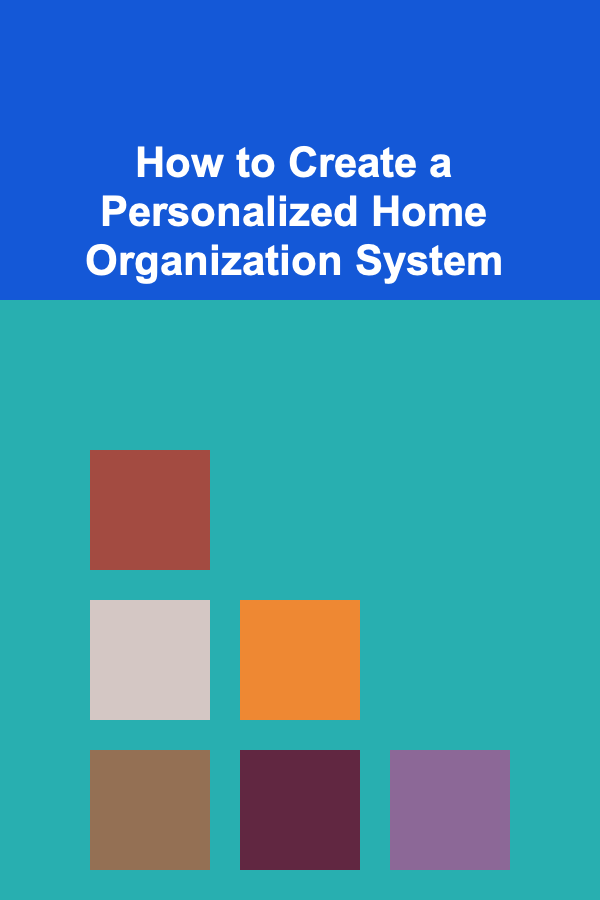
How to Simplify Your Home Budgeting Process for Better Results
ebook include PDF & Audio bundle (Micro Guide)
$12.99$10.99
Limited Time Offer! Order within the next:

Budgeting is an essential aspect of managing household finances. For many people, however, the process of budgeting can feel overwhelming and complicated. Whether it's tracking every expense, managing debt, or trying to make ends meet each month, household budgeting can often seem like a never-ending struggle. But what if the key to financial success lies in simplifying the process?
In this article, we'll explore how you can simplify your home budgeting process for better results. We'll break down practical steps, provide strategies for reducing financial stress, and highlight common pitfalls to avoid along the way. By simplifying your approach to budgeting, you can gain control over your finances, reduce anxiety, and pave the way for a more secure financial future.
The Complexity of Home Budgeting
Before diving into the methods for simplifying home budgeting, it's important to understand why budgeting can be so complex in the first place. Household finances are multifaceted, involving:
- Multiple income sources: Salaries, side gigs, passive income streams, etc.
- Variable expenses: Groceries, utility bills, transportation, etc.
- Fixed expenses: Rent, mortgage payments, car payments, etc.
- Savings and debt: Emergency savings, retirement contributions, loan repayments, etc.
For many households, these categories can feel like a maze, and keeping track of everything in detail can be time-consuming. Additionally, financial life doesn't stand still---expenses change, income fluctuates, and unexpected costs arise. As a result, traditional budgeting methods can become overwhelming, leading to burnout and frustration.
But it doesn't have to be this way. Simplifying your budgeting process can lead to clearer financial priorities, better decision-making, and greater peace of mind. Let's take a closer look at how to do just that.
Step 1: Understand Your Financial Landscape
The first step in simplifying your home budgeting process is to have a clear understanding of your financial situation. This doesn't mean tracking every penny for the next year but getting a broad overview of where you stand financially. When you know what you have coming in and what you have going out, you can make better decisions.
Track Your Income
Your income is the foundation of your budget. Understanding exactly how much money is available to you each month is critical. For households with a single income source, this step is straightforward. However, if you have multiple income streams, the process may be a bit more complex.
Here's how to get started:
- List all income sources: Include your salary, side hustle income, investment income, or any other source of money.
- Account for regularity: Is this income regular (monthly salary) or variable (freelance earnings)? Knowing this will help you plan more effectively.
- Estimate monthly totals: If your income is variable, estimate an average income by reviewing past months or seasonal trends.
Having a firm grasp on how much you earn each month will help you plan a budget that doesn't exceed your means.
List Your Expenses
Next, list all your expenses. These can be broken down into two broad categories:
- Fixed Expenses: These are the expenses that don't change month-to-month, such as rent or mortgage, utilities, loan repayments, and insurance premiums.
- Variable Expenses: These include groceries, transportation, entertainment, dining out, and other discretionary spending.
By identifying these expenses, you'll see where your money is going and how much you need to allocate each month to cover these costs.
Track Irregular Expenses
Irregular expenses, such as annual insurance premiums, holiday gifts, or maintenance costs, can throw off your budget if you don't plan for them. Take note of these irregular expenses and divide them into monthly portions so they don't surprise you when they arrive.
Step 2: Categorize and Prioritize Your Expenses
Once you've tracked your income and expenses, the next step is to categorize and prioritize those expenses. Simplifying your budget involves focusing on what matters most and streamlining your spending to match your priorities.
Identify Essential vs. Non-Essential Expenses
One of the most effective ways to simplify your budget is to distinguish between essential and non-essential expenses. Here's a breakdown:
-
Essential Expenses: These are necessary for your basic living needs and typically cannot be reduced in the short term. Examples include:
- Housing (rent, mortgage)
- Utilities (electricity, water, heating)
- Transportation (gas, car payments)
- Groceries
-
Non-Essential Expenses: These are discretionary expenses that can be reduced or eliminated to save money. Examples include:
- Entertainment (subscriptions, streaming services)
- Dining out
- Travel and vacations
- Luxury purchases
Create Spending Priorities
After categorizing your expenses, determine which ones are most important to you and your household. By focusing on your priorities, you can simplify your spending and avoid overspending on less important items.
For example, if your family values dining out and travel, prioritize those expenses. But if you're focused on saving money or paying off debt, you might choose to reduce spending in non-essential categories like entertainment or luxury items.
Step 3: Choose a Budgeting Method That Works for You
Not all budgeting methods are created equal. Some people prefer detailed spreadsheets, while others may prefer a more minimalist approach. The key is to find a budgeting method that works for your lifestyle and goals.
Here are a few simplified budgeting methods that can streamline the process:
1. The 50/30/20 Rule
This budgeting method is popular for its simplicity. It involves allocating your monthly income into three broad categories:
- 50% for Needs: This includes all essential expenses like housing, utilities, transportation, and groceries.
- 30% for Wants: This includes non-essential spending like dining out, entertainment, and discretionary purchases.
- 20% for Savings and Debt: This portion of your income goes toward building an emergency fund, saving for retirement, or paying off debts.
By using the 50/30/20 rule, you focus on your core financial priorities without getting bogged down in tracking every individual expense.
2. The Zero-Based Budget
In a zero-based budget, every dollar you earn is assigned to a specific category. The goal is to allocate your income until your budget equals zero, meaning every penny is accounted for. While this method can require more time and effort, it can be effective for households that want to take full control of their spending.
If you have variable income, you may need to adjust your zero-based budget each month to reflect changes in your income and expenses.
3. The Envelope System
The envelope system is a cash-based budgeting method that involves allocating a certain amount of money for each expense category. Each category has its own envelope (physical or digital), and once the money in the envelope is gone, no more spending is allowed in that category for the month.
This system helps prevent overspending, particularly in non-essential categories, and is ideal for people who tend to overdraw their accounts or impulse-shop.
Step 4: Automate Where Possible
Automation is one of the most effective ways to simplify your budgeting process. By automating certain aspects of your finances, you can ensure that essential expenses are paid on time, saving you both time and stress.
Here's how to automate:
- Bill Payments: Set up automatic payments for recurring bills such as utilities, mortgages, and credit card payments. This will help you avoid late fees and reduce the likelihood of missing payments.
- Savings Contributions: Automate transfers to your savings account or retirement fund. Even a small contribution each month can add up over time.
- Debt Repayments: Set up automatic payments for your loans or credit cards to avoid missing due dates and accruing interest.
By automating these basic financial tasks, you free up time and mental energy to focus on other areas of your budget.
Step 5: Regularly Review and Adjust Your Budget
The final step in simplifying your home budgeting process is to regularly review and adjust your budget. Life changes, and so do your financial needs. The more often you check in with your budget, the better you can make adjustments to stay on track.
- Review Your Income and Expenses: If your income changes, or if you discover that you're spending more than expected in certain areas, adjust your budget accordingly.
- Set Goals: Whether it's paying off debt, building savings, or saving for a large purchase, having specific goals in mind can help you focus your efforts.
- Be Flexible: Your budget doesn't have to be rigid. If you find that a certain method isn't working, don't be afraid to try something new. The most important thing is that your budget works for you.
Step 6: Use Technology to Your Advantage
Finally, consider using budgeting tools and apps to make the process easier. There are a variety of financial management apps designed to track income, expenses, and savings goals with minimal effort. Some popular budgeting apps include:
- Mint: Automatically tracks and categorizes your spending, provides insights into your financial habits, and helps you stay on track with your budget.
- YNAB (You Need a Budget): Focuses on giving every dollar a job and helps you plan for future expenses.
- EveryDollar: A simple budgeting tool that helps you create a zero-based budget and track your spending.
Using technology to track your finances can greatly simplify the process and reduce the mental load of managing your budget.
Conclusion
Simplifying your home budgeting process is key to achieving better financial results. By understanding your financial situation, categorizing and prioritizing your expenses, choosing a suitable budgeting method, automating payments, and regularly reviewing your progress, you can gain greater control over your finances.
Remember, budgeting doesn't have to be a complicated or stressful process. With the right approach and mindset, it can become a simple, empowering tool that helps you achieve your financial goals and build a secure future. By simplifying your budgeting process, you are investing in your financial well-being and paving the way for better financial health.
Reading More From Our Other Websites
- [Personal Care Tips 101] How to Choose a Body Spray with Your Favorite Scent Notes
- [Home Rental Property 101] How to Maintain Your Rental Property to Keep Tenants Happy
- [Home Maintenance 101] How to Clean and Maintain Your Home's Gutters to Avoid Blockages
- [Home Rental Property 101] How to Market No Credit Check Apartments to Attract Quality Tenants
- [Star Gazing Tip 101] Starlight Sparks: Transforming Astronomical Wonder into Everyday Innovation
- [Home Cleaning 101] How to Keep Your Home Smelling Fresh All the Time
- [Home Lighting 101] How to Add Lighting to Your Entryway to Make a Great First Impression
- [Biking 101] The Ultimate Guide to Bike Hubs: Features, Types, and Maintenance
- [Organization Tip 101] How Radiant Floor Heating Can Improve Your Home's Comfort
- [Organization Tip 101] Understanding Emergency Power Generator Sizing and Requirements

How to Build a Checklist for Improving Your Emotional Intelligence
Read More
How to Create a Home Office with Smart Storage Solutions
Read More
How to Create a Personalized Home Organization System
Read More
How to Let ChatGPT Help You Learn Physics
Read More
How To Identify "Proof" That Isn't Proof in Conspiracy Claims
Read More
How to Create a Vertical Herb Garden Indoors
Read MoreOther Products

How to Build a Checklist for Improving Your Emotional Intelligence
Read More
How to Create a Home Office with Smart Storage Solutions
Read More
How to Create a Personalized Home Organization System
Read More
How to Let ChatGPT Help You Learn Physics
Read More
How To Identify "Proof" That Isn't Proof in Conspiracy Claims
Read More